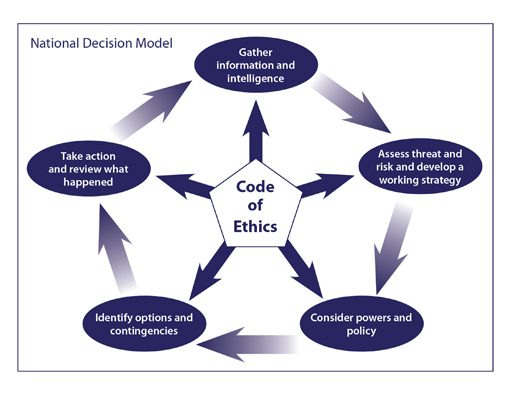4 Identifying potential solutions
4.1 Decision making in policing
In the following video, Police Officer Ben Hargreaves discusses the challenges around decision making for community safety.

Transcript
While this is a powerful framework for problem solving (and has been adopted by police forces across the UK) it cannot be seen in isolation from the underlying social and psychological perspectives. Your own personal biases and preferences will have an impact on how you understand and interpret data and the way you relate to policies and ‘objective’ guidelines. Much of this will also be impacted by culture and the unspoken rules evident in organisations.
The National Decision Model
The NDM is a police framework designed to make the decision-making process easier and standardised. It should be used by all officers, decision makers and assessors who are involved in the whole decision process. Not only is it used for making decisions but to assess and judge those decisions. It can also be used to improve future decisions and help to create techniques and methods for many different situations.
The NDM is based around the police force mission statement and the Code of Ethics, which should be considered when completing each of the stages. You should ask yourself whether the action you are considering is consistent with the Code of Ethics, what the police service would expect, and what the community and the public as a whole would expect of you.
The NDM stages are:
Stage 1 Gather information about the problem in hand. Not only should you work out what you do know, but what you do not know. You will use the information gathered in stage 1 throughout the rest of the process and also when your decisions are being assessed and judged after the event.
Stage 2 Determine the threat, its nature and extent so that you can assess the situation and make the right decisions. Ask yourself, do you need to take the necessary action straight away or is this an ongoing problem? What is the most likely outcome and what would be the implications? Are the police the most appropriate people to deal with the problem, and are you best equipped to help resolve the problem at hand or would somebody else be better?
Stage 3 Knowing what the problem is, you will need to determine what powers you and the police have to combat the problem. Ask yourself which powers will be needed and if the required powers and policies need any additional or specialist assistance to be instigated and introduced. Is there any legislation that covers the process?
Stage 4 Armed with all of the information regarding the problem and any policies and other legislations that may exist, you are in a position to draw up a list of options. You should also use this opportunity to develop a contingency plan or a series of contingencies that can provide you with a backup plan if things do not go exactly to plan.
Stage 5 Once you have determined the most appropriate action, it is time to put this in place. Perform the most desirable action and, if necessary, begin the process again to get the best results possible. Review the process and determine whether or not you could have done things better and what you would do in the future if you were faced with a similar, or the same, problem.
When it comes to policing, there are many standard decision making models to refer to such as OSARA and the National Decision Model. What they share is an attempt to put a common, objective framework on decision making efforts so that decisions can be objectively supported and justified, can be explained to colleagues and can be clearly analysed for lessons and understanding after the fact

